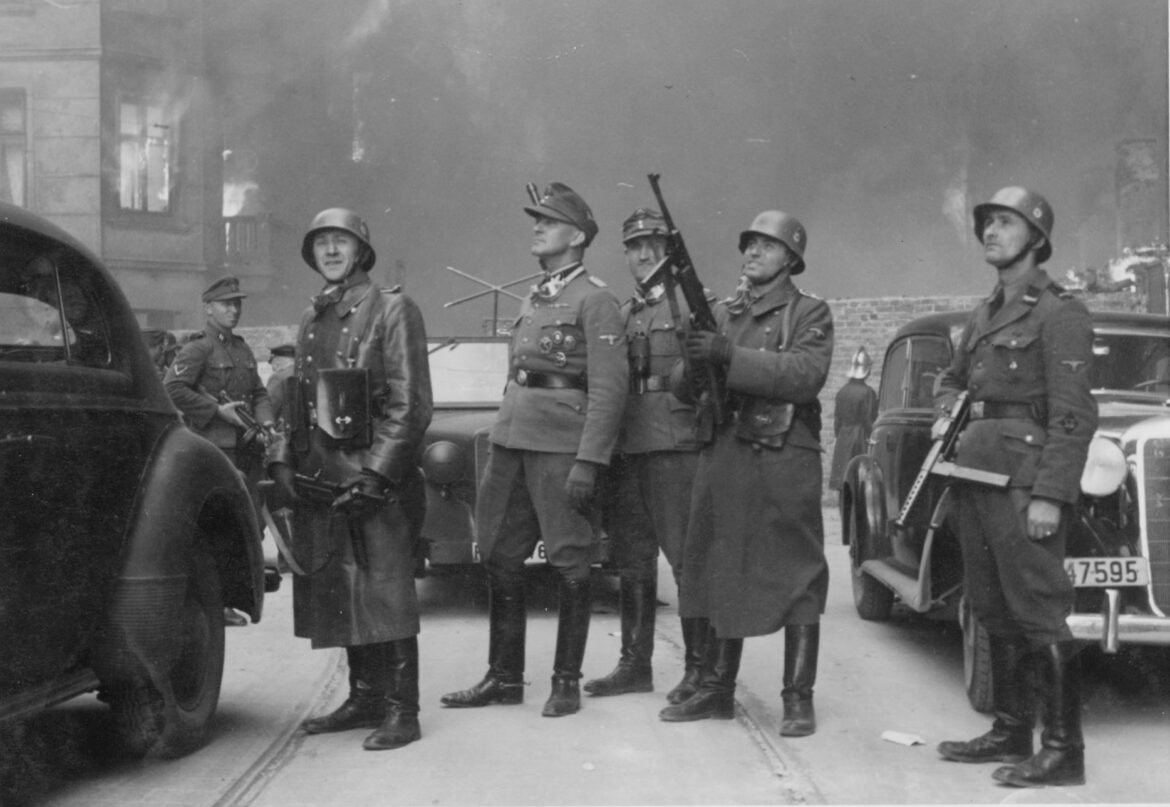The Germans thought that the armed resistance in the Warsaw ghetto would last only three days. In their predictions, they planned to defeat the Jewish insurgents militarily and liquidate the ghetto as soon as possible. Perhaps the entire action was planned to be completed even faster when they realized that the uprising broke out on April 19, that is just one day before Hitler’s birthday.
As the first day of the uprising showed, contrary to the Germans’ assumptions, there were many fierce skirmishes and defeating the Jews turned out to be not easy. The ghetto was defended from the second half of April 1943 until the middle of June 1943, when the last group of the Jewish Military Union, headed by Paweł Frenkel, died in the bunker at Grzybowska Street.
During the German-Jewish battle in the ghetto, the German killers used a total of 1,174 rifles, 135 automatic pistols, 69 light machine guns, 13 heavy machine guns, cannons, flamethrowers, 3 armored cars and tanks. Their military advantage was huge. The action was initially commanded by the head of the Warsaw SS and police, Col. Ferdinand von Sammern-Frankenegg. However, on the afternoon of April 19, after a few hours’ break in the fighting, SS General Jürgen Stroop took command and the Germans entered the ghetto for the second time.
The Jewish insurgents did not create one underground organization. They fought Germans in the ghetto with two separately defending underground structures – the Jewish Fighting Organization (ŻOB), led by Mordechaj Anielewicz, with left-wing political views, and the aforementioned Jewish Military Union (ŻZW), which grouped about 150 right-wing Zionists-revisionists. The first organization grouping about 500 fighters contacted the Polish Home Army which tried to militarily help the fighting Jews. When the uprising in the ghetto broke out, the Polish People’s Guard also joined the armed action out of the ghetto. Unfortunately, in the face of the German advantage, the combat operations of the Polish underground (code name “Ghetto), which were carried out at the ghetto walls and within its territory, did not bring the expected results.
The long-lasting resistance of Jewish insurgents resulted not only from their determination and thoughtful resistance but also from great ingenuity in hand-to-hand combat tactics in urban conditions. The reports of the Home Army described this urban guerrilla warfare with admiration. The ghetto became a huge labyrinth of underground shelters and bunkers. It is estimated that there could be about 500 shelters. Therefore, the only way to finally defeat the Jews was to force them to leave their hiding places by systematically setting fire to houses. Earlier, the Germans turned off the lights and gas in the ghetto and cut off access to water, while packs of trained dogs hunted the Jews in hiding. On April 26, Stroop reported that burning buildings proved “the only and final method to get this rabble and subhumans to appear above the surface.” It is significant that the German killers negotiated with the Jews, but the insurgents rejected the German ultimatum to lay down arms.
When the occupier began to destroy the ghetto buildings, the situation in the bunkers became very difficult for the Jewish population hiding there. Stella Fidelseid reported after the war: “After a dozen hours, there was no more air, the children cried terribly, the women began to faint, in the afternoon the light went out, and in the darkness, the anxiety grew stronger. The youth began to punch holes in the chimney with crowbars to let air in. But after punching the hole, the flames burst into the center… ”.
Stroop stated in his daily reports that from April 20 to May 16, 1943, 56,065 Jews were detected and killed. He specified that about 7,000 were murdered on the spot, 6,929 were sent to Treblinka II, and up to 6,000 died in combat, as a result of poisoning or in fires. The rest, about 36 thousand were taken to other camps (Poniatowa, Majdanek, Trawniki). However, historians claim that those figures were deliberately overestimated by German forces to somehow explain the long-lasting failure to break down Jewish resistance. Probably in April 1943, there were no more than 40,000 Jews in the ghetto. As for the German losses, they are rather difficult to estimate. The Polish underground press wrote about 86 killed Germans and 420 wounded. Stroop in his report revealed 16 killed and 85 wounded.
The symbol of the fierce will of the fight was the attitude of the ŻOB headquarters staff in the bunker located at Mila Street. On May 8, 1943, when the Germans discovered it, blocking 5 out of 6 entrances, many fighters committed suicide or asked their comrade-in-arms to kill them, to not get into German hands. As Cywia Lubetkin writes, “combat troops were only lodgers there. The hosts here were the so-called «Czumpi» – people of the Warsaw underworld. They cut deep into the ground, built a large and strong bunker […] equipped with an electrical installation, […] a well, water supply, a kitchen, a reading room and a room for … entertainment. […] The bunker was ruled by Shmul Osher – the leader of the gang, a big, obese giant. […] “. Only a small group survived the German siege by leaving the sixth undiscovered entrance to the shelter.
The ghetto officially ceased to exist in the German documentation on May 16 at 20.15, when Stroop, as a symbol of German victory, ordered to blow up the Great Synagogue at Tłomackie Street.





